Basketball Drills - Defense Shell Drills, Half-Court Drills
By Dr. James Gels, From the Coach’s Clipboard Basketball Playbook"Helping coaches coach better..."
Disclosure: This page contains affiliate links, which means that Coach's Clipboard receives a small commission (at no cost to you) if you make a purchase using these links.
Shell Drill
This drill focuses on the basic concepts of "on-ball", "deny", and "help-side" (see Basic Defense).Set-up:
Use a half court setup with 4-on-4. Four offensive players are positioned around the three point arc. Start with two wings and two players in the corners. Match-up four defensive players with each of the offensive players. You could also use five on each team with a point guard, two wings and two corners. Additional players can sub in and out at your discretion.
The Drill:
The offensive players are initially stationary, with no cuts or dribbling. This is a defensive drill and the offensive players just pass the ball around the arc. Make sure they make good passes (use this as a passing drill also), Make sure they receive the ball in "triple threat" position, and also have them make skip passes.
The defensive players do not steal or intercept the ball, since this drill is designed to emphasize proper positioning on the floor. The defensive players work on correct positioning between the ball and the offensive player they are guarding. After drilling the basics, you can go to the "live shell" drill, or the "4-on-4-on-4 three stops drill" (below), and make it competitive.
On-Ball Defense
If the defender's man has the ball, he/she should be applying "on-ball" pressure, and force the offensive player toward the sideline or baseline.Deny Defense
If your man is one pass away, you should be in "deny", but not a complete dead-ball denial as seen at the bottom of this page. You should be a little up the line and a step or two toward the ball (X2 in diagram A and X1 in diagram B). This way, you are in position to steal the pass, and yet still be able to give help if the ball-handler tries to dribble-penetrate.Helpside Defense
If your man is two passes away, you should be in "help-side". If the ball is above the free-throw line (Diagram A), the help-side defender should have one foot in the lane. If the ball is below the free throw line (Diagram B), the help-side defenders should be straddling the "help-side line".Importantly, players must quickly rotate and sprint in and out of helpside. Sometimes players get lazy in their rotations. You must impress upon them the importance of rotating quickly. For more of an explanation, see Basic Defense.
Once you feel your team has an understanding of these basic relationships, and all players have been on offense and defense, you can let them play half court live with cutting, screens, shooting, etc. Watch the defenders carefully for correct defensive positioning. Blow your whistle when you need to make points with the players.
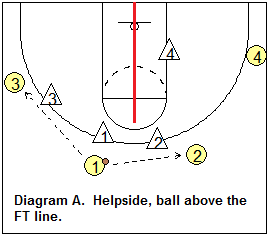
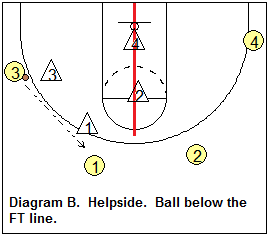
Full Denial
Diagrams C and D below.Now let's assume that the ball-handler has given up the dribble. He/she no longer has the option of dribble-penetration, so the on-ball defender should be up tight and harassing. The defenders whose man is one pass away are now in complete deny, on the line.
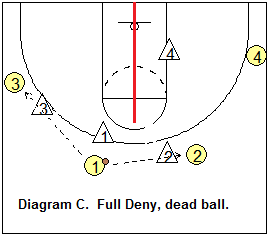
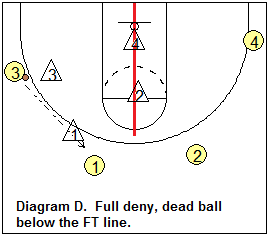
Help and Recover
Diagrams E and F below show how to give help and recover on the perimeter. O1 tries to dribble-penetrate. The X2 defender gives help and O1 is prevented from penetrating, and has to dish back out to O2 (Diagram F). The X2 defender then has to rotate quickly out to on-ball defense on O2, and the X1 and X4 defenders are now in deny, a little up the line and a step or two toward the ball, while the X3 defender moves into help-side (Diagram F).Teach your defenders that when helping on the dribble, we are not trapping. Just stop the ball and recover quickly.
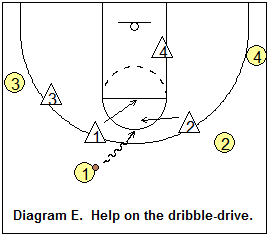
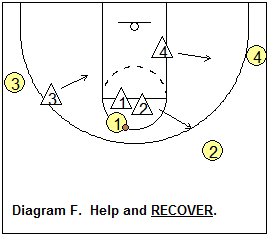
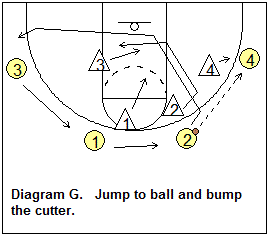
Defending the Cutter
Diagram G shows how to defend the cutter after the ball is passed to the corner. First, whenever a pass is made, defenders should "jump to the ball", which means that as soon as the ball leaves the passer's hands, the defenders should already be stepping toward the ball.So when O2 cuts, the X2 defender should already be in a position to step in front of the cutter and stay between the man and the ball throughout the cut. If O2 cuts out to the opposite corner or wing, note that X2 stays in the lane in helpside. O3 and O1 offensive players rotate to the right. Notice how the X3 and X1 defenders also give help on the cut inside.
4-on-4, 5-on-5 live shell
After teaching the basic rotations and principles, you can go live and make the drill competitive. Play until one team scores five baskets. Switch defense to offense whenever there is a defensive stop. Losers do push-ups (or run). We often go 5-on-5 (with a post player) when drilling against baseline dribble-penetration and double-teaming the low post.4-on-4-on-4 (5-on-5-on-5) live shell
With this drill, we have three teams. If we have 15 players on the squad, we will play 5-on-5-on-5. This is a fast-moving half-court drill. We start with one team on offense, one on defense, and one waiting on the sideline. The first team to score five baskets wins, and the losers do push-ups or run.The offense stays on the court until they are stopped. If the defense fails to stop them, the team waiting on the side becomes the defense. If the defense stops the offense, they now become the offense, the offense goes to the sideline, and the sideline team becomes the defense. We may play two or three games depending on how much time we have.
Keep the drill moving and make sure the sideline team steps quickly onto the floor. In fact, we even allow the offense to get a quick basket even if the defense is not yet ready. This teaches them to be ready and transition very quickly.
4-on-4-on-4 (5-on-5-on-5), three stops
We like this competitive, tough, half-court drill. We have three 4-player teams. A team can only win when it is on defense. One team starts on offense 4-on-4, while the other is on defense, man-to-man.If the offense scores, the defense is "out" and steps off the court, the offense becomes the defense, and the sidelined 4-player team becomes the new offense. The defensive team tries to get 3-consecutive defensive stops - it has to be three in a row.
Once a defensive team accomplishes this, the drill is over and the other two teams do push-ups (or run). We may repeat this drill for two or three games. If you have 15 players, you can also run this drill 5-on-5-on-5.